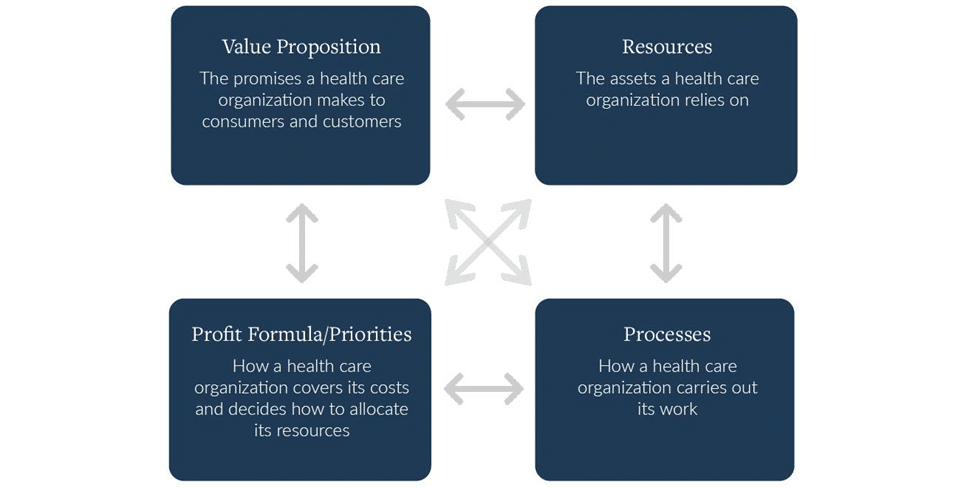What are health care organizations capable of? How much change can they bear? What types of innovations can they successfully deploy? Which ones require a fundamental restructuring of how organizations operate?
The answers to these questions lies in a deeper understanding of business models, which ultimately determine what organizations can and cannot do.
The Christensen Institute has a unique framework that clarifies the often nebulous concept of a “business model.” (See Figure 1.) The framework defines a business model as four interlocking elements that, when taken together, create and deliver value: value proposition, resources, processes, and profit formula/priorities.
Figure 1. The four components of a health care business model

Note: This graphic was originally published in Clayton M. Christensen and Mark W. Johnson, “What Are Business Models, and How Are They Built?” Harvard Business School Module Note, August 2009 (revised November 2021). It has been modified to focus on health care business models.
Business models determine an organization or company’s capabilities (what it can and can’t do) and its priorities (what it must accomplish). This, in turn, defines which innovations it can and will pursue.
The framework is powerful because it enables the prediction of which initiatives will succeed and which ones will fail. It’s critical for leaders to understand these four components of a business model so they know what to leverage from their core business when they need to employ a new business model approach.
What makes up a business model
The first component of the business model is the value proposition, or the set of value propositions, a company offers to its customers. These are the promises an organization makes to fulfill customer needs or goals. Most businesses have multiple value propositions, which are delivered to customers as products or services. In health care, this includes promises the organization makes to its consumers (a.k.a. patients or members) and customers (a.k.a. insurers or employers) as the two are often different.
Resources are required to deliver value propositions. These are assets—people, technology, products, facilities, equipment, brands, and cash—that can be both tangible and intangible.
As an organization works to deliver its value propositions repeatedly and effectively, processes emerge. These are the habitual ways of working together that emerge as people address repeated tasks successfully. Some processes are explicitly stated, documented, and followed. Others are unstated and executed as part of the unspoken culture. Examples include training, budgeting, planning, performing a well-visit exam, etc.
To cover all the costs associated with the resources and processes needed to deliver on the value propositions, and establish a margin to promote sustainability, organizations create a profit formula. This defines how the company will maintain viability and sustainability to support its cost structure over time. To support its profit formula, organizations establish priorities that encompass policies, rules, and culture to guide investment decisions about how to use resources and processes to deliver the value proposition.
How business models solidify
In an organization’s early days, when it is operating as a startup, all business model components are flexible. To survive infancy, organizations pivot their value propositions and adjust their resources and processes until they identify how to bring in the revenue they need to survive. Once this is determined, business model components become increasingly interdependent and resistant to change, especially in successful organizations. The ways in which the four components reinforce one another makes the business model highly interconnected, and thus more challenging to alter the longer it exists.
This happens because when resources and processes meet a need or solve a problem, they get replicated, repeated, improved, and standardized. Even though value propositions were an organization’s starting point, a mature organization can only successfully deliver value propositions that fit its existing resources, processes, and profit formula. As a result, all four components become interdependent, creating a durable set of capabilities and priorities.
What about innovation?
So what occurs when leaders call for a change to the business model? If a proposed innovation creates friction with established capabilities, it won’t gain internal traction. Similarly, if it threatens the existing profit formula, it won’t survive. As models solidify and strengthen over time, employees become stakeholders with vested interests in supporting how the organization works. If a change or innovation threatens the established way of doing things, stakeholders will use their political power to resist the change and uphold the status quo.
This occurs because every resource and process in a settled, successful organization exists to solve a problem for the company and to support delivering the established value propositions to consumers and customers. Stakeholders resist change that threatens the established model as long as the purpose for which the model was created still exists.
This poses a challenge in our current health care landscape where traditional organizations are seeking to shift to value based care. We also see this conflict arise as traditional organizations seek to address drivers of health (a.k.a. social determinants of health), which aren’t established parts of their value propositions and profit formulas, nor their solidified capabilities that have led to past success.
As a result, if leaders of established organizations want to pursue an innovation that conflicts with their existing capabilities and priorities, they must establish a new business unit with a new business model approach.
In our latest paper, coming out next week, we’ll share how this business model framework applies to leaders seeking to address drivers of health, and provide guidance for leaders to follow on their transformation journey.
Note: This blog builds off of the HBS course note referenced under Figure 1, as well as the overview of business models found in the Institute papers “Will schools change forever?” and “You are what you treat.”



